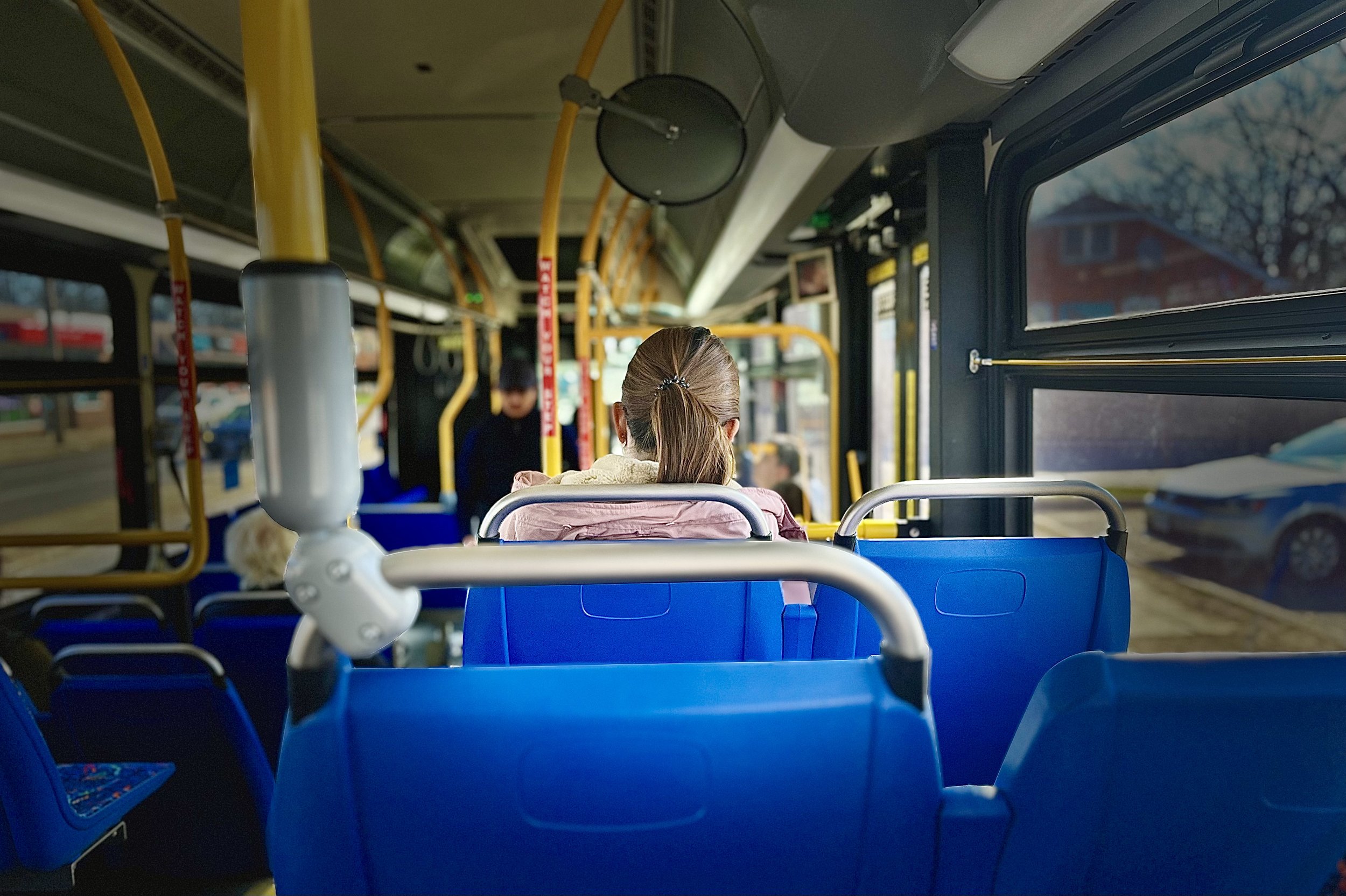Next Stop: Improving Bus Safety for Women
Woman riding on city bus (Photo by: D. O’Reilly. London, Ontario in Spring 2023)
In Canada, research shows that women are far more likely to be victims of assault and harassment on public transit than men.
The bus is meant to get you from A to B. But, as women who use the bus know, instances of unwanted attention and harassment can also be an in-built part of the journey. The gender-based risks women face being subjected to during their bus journey are wide reaching: unwanted staring and leering; sexual comments, verbal threats and intimidation; indecent exposure; unwelcome touching and groping; as well as rape and other forms of sexually-based physical violence. These risks have serious knock-on effects for how women perceive and use their city’s public bus system.
For many women, the immediate ‘solution’ to harassment on the bus is to avoid eye contact, travel in the safety of groups or pairs, and to prepare for dangerous situations by constantly operating on high alert. For some women, the ‘solution’ is to stop using the bus altogether. It shouldn’t be this way. Women should be able to exercise their ‘basic right to the city’ - to use the bus without fear for their personal security and without having to adjust, curtail, or cease their travel activity due to their gender.
So, what can be done?
There are many ways in which transit agencies can make the bus network safer for women passengers. This article focuses on three ‘quick wins’: relatively cheap, straight-forward initiatives which can be easily and quickly implemented by transportation departments and transit agencies.
Providing a ‘Predictable’ Service
Issue: Women wait in unsafe circumstances for unreliable buses
According to the ‘whole journey’ approach, considerations for women’s travel- related security concerns ought to begin before a woman even steps foot on the bus. Indeed, the location of waiting - the bus stop - plays a critical role in many women’s perceptions of safety. Women report increased levels of concern when waiting alone at bus stops, particularly at night and at those in remote locations.
Beyond providing a service that is frequent and reliable (which are also remedies for this issue, but are time and resource intensive, rather than being ‘quick wins’), transit providers should also focus on providing a service that is ‘predictable’.
Predictability is important for women using the bus. When women are provided with information about exactly when - or if - their scheduled bus will arrive, they are able to determine how long their wait at the bus stop will be. This information can then be used to make a more informed decision about how they proceed with their journey. If a woman knows that her bus will only be a minute late, she may decide that waiting at the stop is the best course of action. If she is made aware that the bus is 20 minutes behind schedule, she may feel that it is safer to walk to the next bus stop or seek an alternative form of transportation, such as a ride hail.
Quick Win: Install real-time countdown timers at bus stops
Countdown timers, like the ones that have been installed at bus stops across the UK, can provide real-time information about the arrival time of buses. Countdown timers are particularly useful for women who may, for various reasons, not have access to a phone with internet (and therefore online navigation apps) whilst waiting for their bus.
TfL Countdown Timers at bus stop in London, U.K. (photo via TfL Webpage).
Ensuring Adequate Visibility On Board
Issue: Women aren’t always able to scan their surroundings on board
Poor visibility is frequently cited as a prominent security concern for women using buses and other forms of public transportation.
One of the primary culprits is poor lighting. Understandably, inadequate lighting has been shown to have a direct influence over women’s negative perceptions of safety on public transit. While on board a bus, women have a vested interest in being able to keep tabs on other passengers; and poor lighting limits their ability to do this.
Another factor that impedes visibility on buses is poorly placed advertisements that block a bus’s windows, such as the ads that wrap the exterior of a bus in self-adhesive perforated film. This is important because women are often invested in maintaining a sightline of the environment outside of the bus - the space they will be stepping into once they get off the bus. These window-blocking advertisements can impede their monitoring of this external environment.
Inappropriate lighting on public bus (photo via Pittsburgh City Paper)
Limited visibility caused by bus advertisement over windows (photo via Transit Jam)
Quick Wins: Improve internal lighting and restrict use of window-blocking ads
Buses must be equipped with appropriate lighting to ensure visibility on board. ‘Appropriate lighting’ does not mean overly harsh, blinding lighting conditions, which can create a ‘fishbowl effect’ ( i.e. where the interior of the bus is overly lit, but the external environment is dark). Fishbowl effects on a bus are undesirable, especially for women. They create a situation where a female passenger (who is inside an overly lit bus) can be seen by individuals on the outside of the bus who are looking in, but - due to the glare of the lights on the window - she herself, cannot see outside of the bus.
Transit agencies must also ensure that the advertisements they approve to be affixed to their bus fleets do not obstruct the view of the outside environment. Bus advertisements, including those on the exterior of a bus, don’t inherently create a visibility issue - just those that block windows do. In order to rectify this issue, transit agencies simply need to stop permitting those advertisements which cover a bus’s windows.
Effective use of external bus advertising that does not block the view out of the window (photo via Mike Barti)
Accommodating Late Night Passengers
Issue: Women can feel unsafe walking home from the bus at night
Time of day can have a significant impact on how women perceive the dangers of public space - with after-dark periods being viewed as higher risk for women moving throughout the city.
In terms of the bus journey’s final leg, the whole journey experience (door-to-door) once again needs to be considered for women. Women departing a bus can be uncomfortable walking the distance from their stop to their final destination. This is especially true late at night in the dark when women’s fears of being followed and/or attacked are exacerbated.
Quick Win: Implement a Request-a-Stop program
Request-a-Stop programs, like the one that operates in Toronto, allow any woman who is feeling vulnerable to ask the bus driver to stop at any location (including locations that are not designated bus stops) during off-peak night-time hours. The driver is then meant to only allow the woman who requested the stop to get off the bus. Montreal has a similar “Between Stops” program.
Request-a-Stop programs provide those women who are travelling on a bus late at night with important options. Firstly, it can reduce the time a woman spends walking home in the dark by allowing her to get off the bus at a location closer to her end destination. Secondly, it provides women with an exit strategy if there is a situation on the night bus they want to distance themselves from, without fear of being followed.
Rolling Forward
Bus travel needs to better account for the safety and security needs of women. While the three ‘quick wins’ listed above are a positive start to increasing women’s safety and perception of safety while using the bus, they are not enough to solve the problem.
In order to create a bus system that properly protects women we must do more: involve women in key decision making roles in the policy and planning processes related to the bus system, collect evidence-based gendered data, develop effective cultural-change campaigns that engage boys and men, hire more female drivers to represent the community that they serve, and develop effective reporting systems - to name a few.
Addressing the safety concerns of women using the bus is not an impossible task. Many researchers, public campaigners, and women in the community are providing insights, ideas and tools on how we do this. The next step? Getting transit agencies on board.
Resources
https://transweb.sjsu.edu/sites/default/files/2611-women-transportation.pdf
https://www.itf-oecd.org/sites/default/files/docs/womens-safety-security_0.pdf
https://grist.org/article/women-transit-and-the-perception-of-safety/
https://www.strongtowns.org/journal/2016/4/20/woman-public-transit-harassment https://publications.polymtl.ca/10017/1/2022_Gris%C3%A9_Understanding_responding_transit_needs_women.pdf
https://www.imperial.ac.uk/news/196474/women-10-more-likely-than-report
https://grist.org/cities/public-transit-still-isnt-safe-for-women-but-we-can-change-that/
https://www.popsugar.com/love/Sexual-Harassment-Public-Transit-38375301
https://thesource.metro.net/2019/09/19/metro-releases-understanding-how-women-travel-report/
https://www.itfglobal.org/sites/default/files/node/page/files/Women_in_Public_Transport_OPT.pdf






